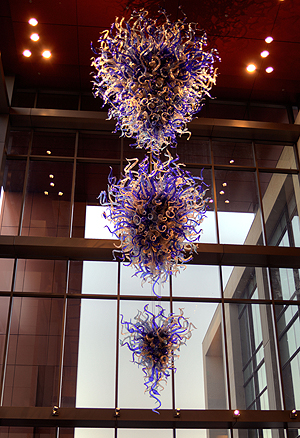October 25, 2010 - By Christopher Vaughan

The Chihuly sculpture, which at roughly 2 tons weighs as much as a Hummer H3, is composed of 2,071 pieces of blue glass that glisten with gold when lit up at night.
When people walk into the Lorry I. Lokey Stem Cell Research Building for the first time, they can’t help but stop and stare, their eyes drawn upward to the imposing 2-ton, blue-glass sculpture that hangs in the atrium. Spanning more than two stories, the artwork, which glistens with gold when lit up at night, is called the Tre Stelle di Lapislazzuli (Italian for “Three Stars of Lapis Lazuli”) Chandelier and is the first — and likely the most attention-grabbing — piece of what researchers plan to be a whole range of art throughout the building.
“Art can inspire people in life’s activities, and artworks provide important symbols that remind us why we are doing what we are doing,” said Irving Weissman, MD, director of the Stanford Institute for Stem Cell Biology and Regenerative Medicine.
Art in the building will also be symbolic of the creative process that the building is designed to foster, Weissman added. “Art, in a variety of media and on all floors, reminds us all of the importance of interaction across disciplines, and that such creative interactions are going on in this place.”
The conception for the chandelier came about during the groundbreaking in 2008, when Weissman had a conversation with Sue McCollum, a local philanthropist who had established a nonprofit organization that supports cancer programs and cancer research. Their conversation turned to Dale Chihuly, a Seattle-based artist who had collaborated with McCollum in the past. Chihuly’s multi-colored glass artworks are featured in permanent and temporary exhibits all over the world.
So Weissman and McCollum decided to ask Chihuly to create some sort of artwork, large or small, for one of a number of possible spots in the building. Ultimately he agreed to create something big for the atrium at the building’s main entrance.
Chihuly said he was pleased to have been asked to create a work of art for the Lokey building. “Art, architecture and science all seem to work interchangeably with one another,” he said.
The Chihuly sculpture was donated by My Blue Dots, the nonprofit that McCollum organized to support cancer research after her own struggle with breast cancer. She was treated at Stanford by radiation oncologist Albert Koong, MD, PhD, who is one of the cancer researchers whose work has since been supported by the foundation. Koong and Weissman are both members of the Stanford Cancer Center.
The genesis of the name My Blue Dots comes from the blue tattoos that served as permanent guide marks for repeated radiation treatments. The nonprofit group supports both science research and artwork to “serve as inspiration for healing, hope and health for cancer patients and their families,” McCollum said.
The 2,071 pieces of glass for the chandelier were blown earlier this year and carefully arranged on metal armatures in Chihuly’s studio in Seattle. The work was so large that it had to be hung in separate pieces. Then it was taken apart, packed in 161 boxes and shipped to Stanford for final assembly, which took place over two weeks in August and September. The finished work is 33.5 feet long and the lower tip dangles 13 feet above the floor. Weighing 4,300 pounds, or roughly the same as a Hummer H3, the chandelier required a few structural modifications in the ceiling during the building’s construction.
Now that the Chihuly chandelier is in place, a search has begun for other artworks. A committee will evaluate possible artworks and reach out to those who might want to support the purchase of art, or donate or lend individual artworks.
Christopher Vaughan is a writer for the the Institute for Stem Cell Biology and Regenerative Medicine.
About Stanford Medicine
Stanford Medicine is an integrated academic health system comprising the Stanford School of Medicine and adult and pediatric health care delivery systems. Together, they harness the full potential of biomedicine through collaborative research, education and clinical care for patients. For more information, please visit med.stanford.edu.